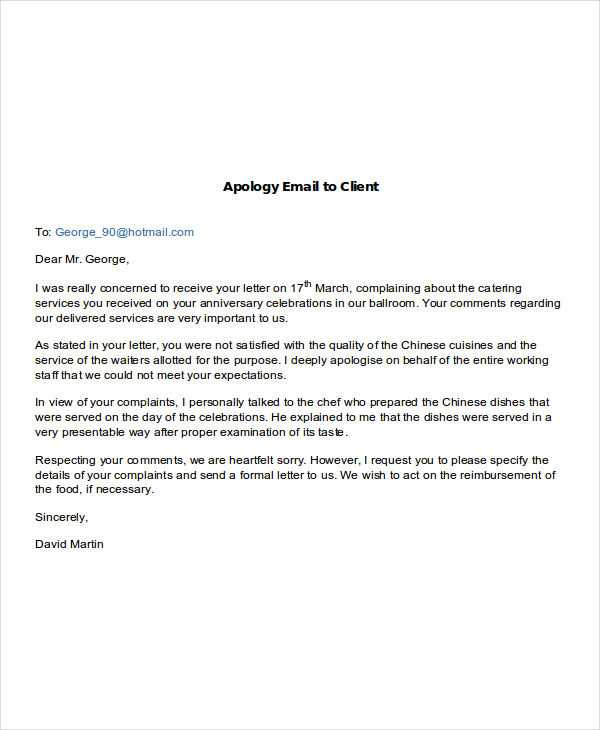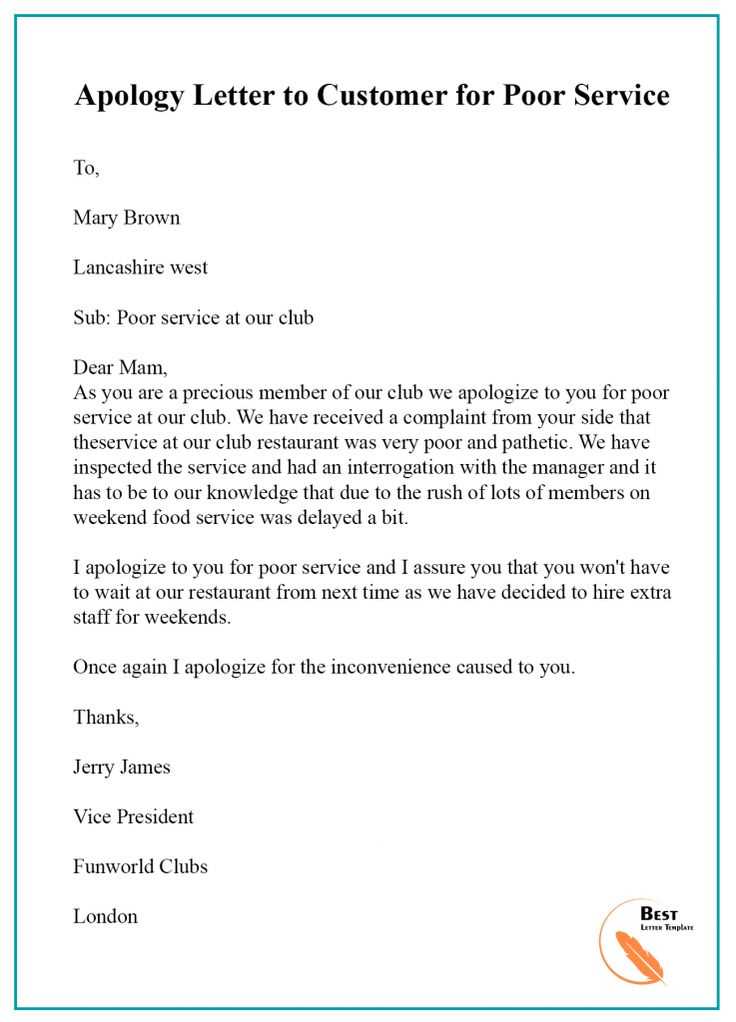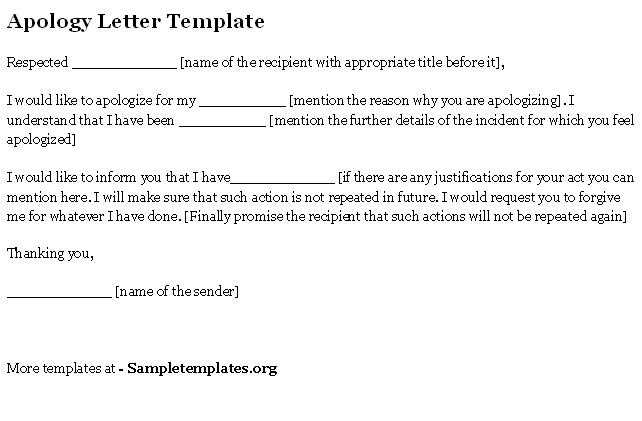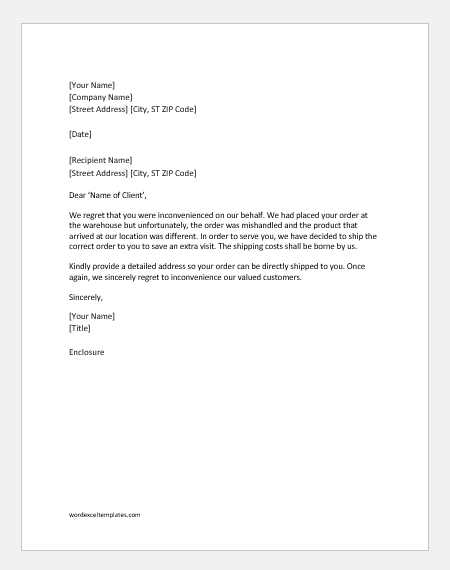Apology letter to client template

Address the situation directly and express regret for the inconvenience caused. Acknowledge the client’s frustration and show genuine concern for the issue at hand. Use a tone that is both professional and empathetic, demonstrating your understanding of how the situation has affected them.
Start by apologizing clearly and unambiguously. A simple, sincere apology sets the right tone for the rest of the letter. It’s important to avoid excuses and focus on taking responsibility. Mention the specifics of the situation that led to the issue to show that you are fully aware of what went wrong.
Offer a solution or next steps to rectify the problem. This demonstrates your commitment to resolving the issue and rebuilding trust. If applicable, provide a clear outline of how you plan to prevent similar issues in the future, highlighting any actions that have already been taken to address the matter.
End the letter by reiterating your apology and expressing your appreciation for the client’s understanding and patience. Make sure to leave the door open for further communication, should they need additional assistance. This helps maintain the relationship and shows your dedication to customer satisfaction.
Apology Letter to Client Template
Start your letter by acknowledging the issue and taking responsibility. Clear and direct language helps to show that you understand the problem and are committed to addressing it.
Key Elements of an Apology Letter

- Subject Line: Be specific, e.g., “Apology for Delay in Delivery” or “Apology for Service Inconvenience”.
- Opening Statement: Apologize without delay. Use phrases like “I sincerely apologize” or “We regret any inconvenience caused.”
- Details of the Issue: Briefly explain what went wrong. Keep it factual and avoid over-explaining.
- Action Taken: Let the client know the steps you’re taking to fix the issue. This assures them that their concerns are being addressed.
- Reassurance: Reaffirm your commitment to their satisfaction. A statement like “We value your business and are working to prevent this in the future” can go a long way.
- Closing Statement: End with an invitation for further discussion, showing your willingness to resolve any remaining concerns.
Example of an Apology Letter

- Subject: Apology for Delay in Delivery
- Dear [Client Name],
- We sincerely apologize for the delay in delivering your recent order. We understand the inconvenience this has caused and take full responsibility for the delay.
- The delay was due to an unexpected issue in our supply chain, which has now been resolved. We have taken immediate steps to ensure that this situation does not occur again in the future.
- We greatly appreciate your patience and understanding. If you have any further concerns, please don’t hesitate to contact us directly.
- Thank you for your continued support.
- Sincerely, [Your Name] [Your Position] [Company Name]
How to Acknowledge Mistakes Professionally
Take full responsibility for the error. Acknowledge it without hesitation or assigning blame to others. This shows that you are accountable and ready to fix the situation.
Explain what went wrong, but keep it concise. Avoid over-explaining or making excuses. Focus on the facts and let the client know you have understood the root cause of the mistake.
Offer a clear solution. Let your client know what steps you’re taking to resolve the issue. It could be a refund, a replacement, or an adjustment to the service provided. Be transparent about timelines and actions.
Express genuine regret. Apologize in a way that feels personal, and avoid generic phrases. Let the client know their frustration is understandable and valued.
Ensure the mistake won’t happen again. Explain the measures you’re putting in place to prevent future errors. This builds trust and reassures your client that their experience matters.
Key Elements to Include in an Apology Letter

Take responsibility right from the beginning. Acknowledge the mistake and avoid shifting blame. Clients value transparency and a sincere admission of the error.
Express genuine regret. Make it clear that you understand the impact the issue had on the client. Personalize the apology to show empathy for their experience.
Offer a solution or compensation. Let the client know how you plan to resolve the issue and what steps are being taken to prevent a recurrence. This assures them that action is being taken.
Maintain a professional tone. While it’s important to be empathetic, avoid overly casual language. The client should feel respected throughout the apology.
End with an invitation for further dialogue. Encourage the client to reach out with any additional concerns, reinforcing your commitment to providing support.
Crafting a Sincere and Empathetic Tone
Begin with a clear acknowledgment of the issue and its impact on the client. This establishes a genuine understanding of their frustration or disappointment. Avoid generalities and focus on specifics that reflect your awareness of the situation.
Use Personal Language
Address the client directly by using “I” or “we” to show responsibility. Phrases like “I regret” or “I understand” immediately signal empathy and care. Keep the tone personal to avoid sounding distant or robotic.
Show Understanding and Offer Apology
When apologizing, clearly state what went wrong. Don’t just say “we apologize”; explain why the issue occurred and express regret without making excuses. A sincere apology comes from acknowledging the inconvenience caused.
- Avoid vague language like “sorry for the inconvenience.” Be specific, e.g., “I apologize for the delayed response, which caused unnecessary stress.”
- Offer reassurance that steps are being taken to address the situation. Highlight any corrective actions or improvements being made.
- Keep the tone humble, showing that the issue is taken seriously and that the client’s experience matters.
Close the letter with a reaffirmation of commitment to the client’s satisfaction. Make sure they feel valued and heard, leaving the door open for future communication. Offer a direct line of contact for any further concerns.
Apologizing for Delays and Service Failures
Begin by acknowledging the specific issue the client faced. Be transparent about the reasons for the delay, and avoid vague or defensive language. Providing an honest explanation helps build trust.
Take Responsibility and Offer Solutions
Accept full responsibility for the failure in service. This approach demonstrates accountability and reassures the client that their experience matters. Avoid shifting blame to external factors or circumstances.
Clarify the steps you are taking to resolve the issue, such as expediting the next service or offering compensation where appropriate. Ensure the client feels heard and that their concerns are being addressed directly.
Reassure the Client
Let the client know that you have learned from this experience. Outline any changes or improvements being made to prevent future issues. Be clear about the actions you are taking to avoid this situation from happening again.
End with a strong commitment to providing better service moving forward and an invitation for the client to reach out with further concerns. Express gratitude for their patience and continued trust.
Offering a Solution or Compensation
Offer a clear and immediate solution to the problem. If possible, provide an alternative product, service, or a practical way to resolve the issue. For instance, if there was a delay in delivery, offer expedited shipping at no extra cost. If a product arrived damaged, offer a replacement or refund. Ensure the solution is straightforward and can be implemented quickly.
Providing Compensation
If the situation warrants compensation, make sure it is fair and appropriate to the severity of the issue. Offering a partial refund, gift card, or discount on future services can show goodwill and restore customer confidence. Clearly state the terms of compensation and how the client can take advantage of it.
Setting Expectations
Explain the steps involved in resolving the issue and outline how long the process will take. Be transparent about any limitations or delays, and provide realistic timelines. Reassure the client that their concerns are being addressed and that their satisfaction is a priority.
Follow-up Steps After Sending an Apology Letter
Once you’ve sent your apology letter, it’s crucial to take specific steps to ensure the issue is fully addressed and the relationship with the client is repaired. First, monitor for any response. If you don’t hear back within a reasonable time frame, consider a follow-up message to confirm that the letter was received and to inquire if any further action is needed.
Key Follow-up Actions
Check the tone and contents of your initial apology. Was it clear and sincere? If you receive a response, evaluate if it indicates that the client’s concerns were genuinely addressed. If not, be prepared to provide further clarifications or solutions. Timely responses to questions or concerns will show that you value the client’s feedback and are committed to improvement.
| Action | Time Frame | Purpose |
|---|---|---|
| Confirm Receipt | 2-3 days after sending | Ensure the letter was received and read |
| Address Additional Concerns | Within a week of receiving feedback | Resolve any lingering issues |
| Offer Compensation (if applicable) | Within 10 days | Show commitment to making things right |
Maintain Open Communication
It’s important to keep the dialogue open after your follow-up. By engaging in consistent communication, you demonstrate that you are proactive in building trust. Regular updates on the progress of resolving any remaining issues can reassure the client and reaffirm your commitment to customer satisfaction.